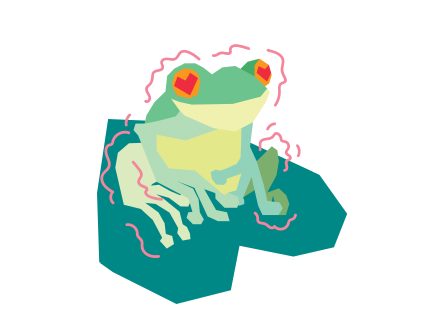Assistant Professor of Biology Jessica Merricks shares her research on courtship communication among animals.
Powered by RedCircle
Quality time, gifts, physical touch, acts of service and words of affirmation. These are the five love languages as defined by author and counselor Gary Chapman that humans look to when seeking a mate.

Like humans, animals also have love languages used in courtship, and Assistant Professor of Biology Jessica Merricks has researched many of these modalities. Starting with her research on visual communication in anole lizards as an undergraduate at Tulane University, Merricks became interested in animal communication. During her undergraduate work, she studied how anole lizards use flaps on their skin to provide visual signals to attract a mate.
Her doctoral dissertation research at the University of Missouri focused on the acoustic communication of pine woods tree frogs. In this research, Merricks studied how male frogs communicated and how female frogs responded, as female pine woods tree frogs don’t make sounds. She analyzed how the female frogs determined which male frog was the most attractive.
While her research specifically focused on lizards and tree frogs, these methods of communication are used across species. Other modalities used by animals include chemical and vibrational. Chemical communication refers to pheromone signals, which are used by many animals including insects and some fish. Aquatic and terrestrial organisms use vibrational signals. Additionally, many animals — including humans — are more complex and use more than one modality. “Even though frogs are mostly acoustic, their eyes also work,” says Merricks, a behavioral ecologist. “They can also use visual cues to communicate.”
This discovery is challenging behaviorists’ foundational ideas about animal courtship, Merricks’ research found. “[Animals] have much more agency than we previously thought in terms of the way they communicate. They can make decisions in ways that we didn’t really expect they could, which is really kind of cool,” she says.

Merricks’ research found that male tree frogs change their strategy when seeking a mate in a competitive environment. “If he’s out trying to attract a mate, he might behave one way if he’s alone,” she explains, “but when there are other male competitors around, he behaves in a completely different way.”
Human-induced environmental changes, including climate change, urbanization and pollution, also impact animal courtship communication. Animals that previously mated in the spring are adapting and now mating in the winter. Physical structures like buildings are impacting the way that sound travels. Pollution in the oceans and air is affecting chemical signals. Road noise is impacting vibrational communication. “For insects that communicate via vibrations, they need to feel the tree that they’re on,” Merricks says. “They are literally feeling the vibrations through the tree that they are sitting on. When a truck goes by with a loud engine, they can feel that rumbling, which means they can’t feel who’s communicating with them.”
However, animals are adapting to these changes to ensure survival. “Those organisms that [can] maybe switch their modality if it’s too loud — focus on visual, for example — those organisms are going to be more successful, while the others are going to be literally drowned out by the noise,” she adds.
Merricks hopes the next generation of behavioral ecologists focus on better understanding how humans impact the environment as animals learn to adapt and evolve. “These aren’t things we’ll notice in our lifetime, but over time, if we document them well, we might be able to actually pinpoint the impact that humans are having on the evolution of organisms,” she says.


